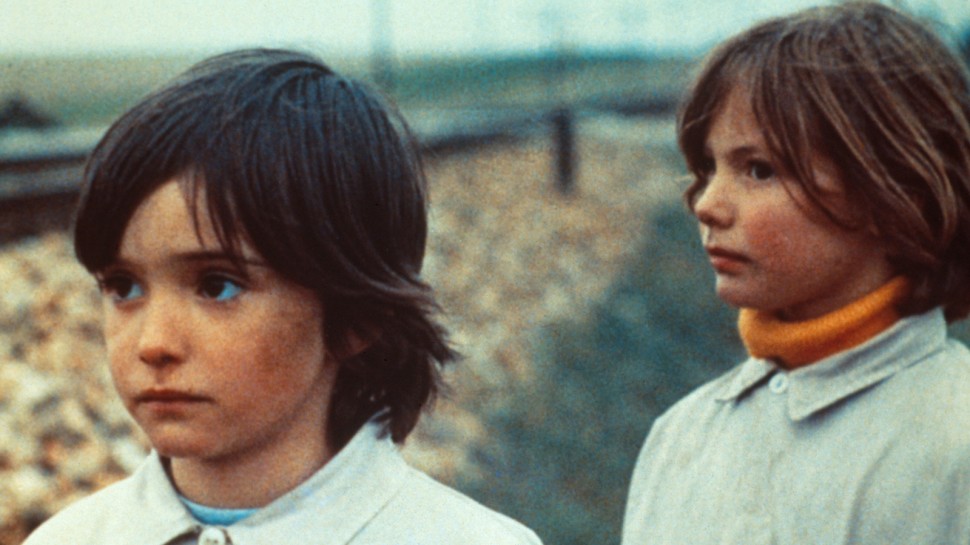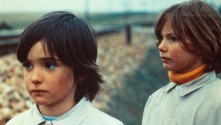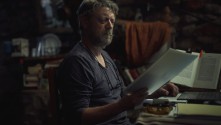
Victor Erice, Full Circle
In the fourth stanza of the Rhine Hymn, Hölderlin states: “For as you began, so shall you remain.” The tradition invoked with that verse has practically nothing in common with the world of Víctor Erice (b.1940), except for one essential thing: the nature of poetry. Writing verses is always a silent way of escaping from exhaustive explanation and remaining for a brief time in the uncertain. How long does it take for El espíritu de la colmena (The Spirit of the Beehive) to combine the sequences of the first act into an intelligible whole?
It is true that everything begins with “Once upon a time,” but this story threads slowly, retaining the indeterminacy of the meaning of the world that the film reveals and those who inhabit it. The two little protagonists go to the cinema, return alone, go to bed and before falling asleep the younger one asks her sister about the movie they saw. She wants to know why the monster killed the girl. Their father is seen working with his honeycomb panels and at night writing a philosophical essay about the world of insects responsible for honey. Meanwhile, the mother writes a letter and immediately goes to the train station to send it to a mysterious recipient. As she puts the letter on the train, a soldier looks at her from the window of a car and she looks back at him: an indecipherable but sufficiently intense exchange takes place, no less ambiguous than the letter. (This sequence that opens the arrival at the station is a prodigious moment, one among many, about the mastery of cinematic space). All this happens over thirty minutes, leading to a scene in which all the characters— for the first time, little by little—come together. There is something in the mise-en-scène that indicates disintegration and fatigue, a mystery covered with a barely expressed discomfort. It is not known, not named, but is perceived. There are two monsters in the film: Frankenstein, in the vision of James Whale, projected in a cinema in a lost town in Spain in the 1940s; and a second abject creature, a monster that is not projected, but is present as the spirit of the times: Francoism.
El espíritu de la colmena is nothing other than the life of a family that seems to live in exile in a small town deep in the Spanish countryside, a place where politics barely register. A photo glimpsed by the little girl in an album reveals that her father had a close relationship with Miguel de Unamuno. Why would an intellectual dedicate himself to beekeeping then? The fact that Maurice Maeterlinck wrote La vie des abeilles (The Life of the Bee, 1901) is not sufficient reason to interpret the destiny of that man, perhaps interested in the same thing, but forced into it by other circumstances. The allusion to Francoism and monsters is fully reflected when the youngest girl, Ana (interpreted by Ana Torrent), driven by curiosity, tries to solve what is monstrous and randomly encounters a person persecuted by the regime. In this context, Ana starts on the path—always incomplete—of understanding finitude. The girl in the movie has died. The man Ana found in an abandoned room in the vastness of the countryside and took care of for a while has also died. Whale's ellipsis protects Ana from contemplating infanticide; nor does she witness a nighttime shooting, though the blood scattered on the ground confirms her suspicion.
Erice's first film is beautiful, a little sad, and always enigmatic: in the last scene, the girl says and repeats, “I am Ana.” In Cerrar los ojos (Close Your Eyes), the filmmaker's latest film, no less masterful than the first, Torrent once again becomes (another) Ana and repeats her name twice. This time she is in front of her father, who has lost his memory. The scene has the same intensity as the indelible closing scene of Erice's debut film and functions here as the preamble to the last scene of Cerrar los ojos, whose title becomes image and sound and, once seen, is impossible to forget. What happens is nothing other than a certainty of what cinema was (without a doubt) and can still be (perhaps) in relation to memory and identity: a spiritual supplement of the self, interwoven with feelings made of images and sounds.
In Cerrar los ojos, a filmmaker was unable to finish his second film, entitled La mirada del adiós (The Goodbye Gaze). In the middle of filming, his lifelong friend and the main actor of the film disappeared. He is presumed dead, but his body has never been found. That happened in 1990. The story itself takes place in 2012, and the link between that almost forgotten misfortune and the present of Miguel Garay—now a translator, far from Madrid and the cinema, near the sea and to the south, in Granada—is brought back by a television program that returns to the unsolved case of Julio Arenas, the missing actor.
What happens after the airing of television program is a knot of secretly extraordinary situations, with singular characters. The story moves in only one direction, the possible reunion of the two friends. They are accompanied on this journey, at different moments by: an old film buff who guards the cans of the two reels of La mirada del adiós (which is seen at the beginning and at the end of Cerrar los ojos and which has obvious affinities with La promesa de Shanghái (The Promise of Shanghai), the film that Erice himself never managed to make); two nuns who love the people around them without reservations and who provide unexpected comedy; an Argentine pianist and singer, who was also the lover of both Miguel and Julio; three of Miguel's neighbors who take care of his dog and his garden when he is away, and who can invoke the happiness of being together by all singing a song from Río Bravo. They are all beautiful, even the host of the television show who is seriously concerned about Julio's whereabouts, and the benevolent nurse who also wants the best for a man whom everyone now calls Gardel, but who could really be that actor who abandoned the world.
It has been said that Cerrar los ojos is more narrative than Erice's previous films. To a certain extent, yes, but the pictorial dimension of many of his shots is hardly lacking. The last thirty minutes are imposed not only by the dramatic suspense inscribed in the script, but also by the behavior of the light in the shots and the laborious planning of the frames. It is evident: the move to digital has not affected Erice, because he has not become an illustrator of stories. He is faithful to Bresson’s idea of the cinema as discovery. Cinematography is more than just cinema. With light and sound, it is possible to transfigure the given world and replace something unmatched and in principle nonmimetic that can only be established through a camera. In fact, there are scenes that transcend their narrative function: observing the composition of the shot showing Gardel's bed that has been made, in the small room the nuns have provided for him in the home for the elderly where he works, is enough for us to witness what a filmmaker can achieve with a single image. There are several such shots. Is it necessary to point them all out? There is the one of the friends watching the sea behind a fence, and the one of the nun going to the room where Miguel is staying, and the one of the father and daughter sitting on a bench at night, in silence, and the one of the moment when the lights of the elderly home go out and the night returns us to the loneliness of those who live there. Nothing has been said about what has been shot on film, the two reels of the film inside the film, with their enchanted allusions to Jorge Luis Borges’ “La muerte y la brújula” (“Death and the Compass”), a spiritual reference. These two sequences vindicate the analog material of cinema.
In both films, the very Argentine tango “Caminito” with its music by Juan de Dios Filiberto and lyrics by Gabino Coria Peñaloza is sung. The lyrics sketch the experience of finitude in a popular key, the same one that Ana once sensed as a child and again now as an adult.
Little path that time has wiped away
Upon which once we were seen walking
I have come for the last time
I have come to tell you of my sorrow
Little path that once you were
Fringed with clovers and rushes in bloom
A shadow soon you will be
A shadow just like me
Caminito que el tiempo ha borrado
Que juntos un día nos viste pasar
He venido por última vez
He venido a contarte mi mal
Caminito que entonces estabas
Bordeado de trébol y juncos en flor
Una sombra ya pronto serás
Una sombra lo mismo que yo
It should be added that El espíritu de la colmena begins with a screening in a cinema and that Cerrar los ojos ends with another. The verse cited at the beginning of this text resonates here. It is Erice's great circle. Although it is not a sphere incapable of breathing, but rather the creation of a sensitivity capable of sheltering a mystery. In the first film, in the cinema, everyone opens their eyes wide; in the second, a paradoxical discovery is revealed: sometimes you can see what you need to see when you close your eyes. Those who study the hermeneutics will be able to say something about the cinema itself, about Erice's entire work or about the character of Julio Arenas. In a recent interview on his last film, Erice cited a poem by Borges, “Una brújula” (“A Compass”): “Behind the name there is something that is not named.” The cinema of the 20th century was sometimes an exercise in intimacy. From time to time, an image can lodge itself precisely in that which is not named. That mystery has always belonged to Víctor Erice. We are lucky to be his contemporaries. – Roger Koza





